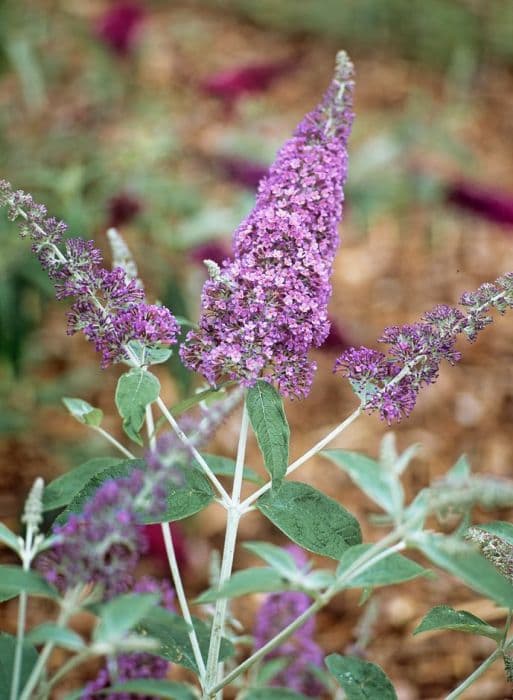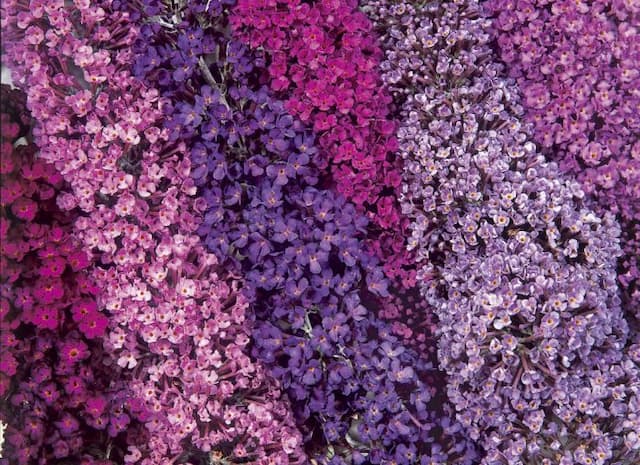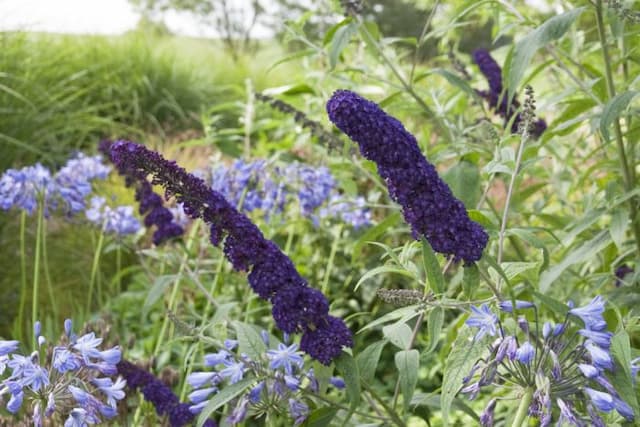Butterfly Bush Buddleja davidii 'Southcombe Splendour'

ABOUT
Buddleja davidii 'Southcombe Splendour', commonly known as the Butterfly Bush, is a deciduous shrub known for its striking and showy appearance. This cultivar is characterized by its arching branches adorned with long, conical clusters of flowers that bloom profusely throughout the summer. The flowers themselves are a magnificent sight, typically presenting a soft, lilac color with orange centers, which stand out against the backdrop of the plant's foliage. The leaves of 'Southcombe Splendour' are slender and pointed, with a length that contributes to the plant's overall lush appearance. They possess a deep green color on the upper surface, while the underside often has a lighter, grayish hue, giving the foliage a two-toned effect which adds to the visual interest of the plant. The texture of the leaves is somewhat rough to the touch due to the presence of fine hairs, a characteristic that is common among Butterfly Bush varieties. As the name suggests, the Butterfly Bush is a magnet for butterflies and other pollinators, making it not just a visual pleasure for gardeners, but also a valuable resource for supporting local biodiversity. Its blooms are fragrant and their sweet scent can attract a bustling community of bees, hummingbirds, and, of course, butterflies throughout the blooming season. The overall aesthetic of the Butterfly Bush 'Southcombe Splendour' is one of vibrancy and vitality, making it a favored choice among gardeners looking to add both color and wildlife-friendly features to their landscapes.
About this plant
 Names
NamesFamily
Scrophulariaceae
Synonyms
Summer Lilac, Butterfly Bush, Orange Eye
Common names
Buddleja davidii 'Southcombe Splendour'.
 Toxicity
ToxicityTo humans
The Butterfly Bush is generally not considered toxic to humans. There is no significant evidence suggesting that the Buddleja davidii 'Southcombe Splendour', or Butterfly Bush, causes poisoning in humans when any part of the plant is ingested. Therefore, there is no list of symptoms associated with poisoning from this plant for humans, as it is typically recognized as non-toxic.
To pets
The Butterfly Bush is also generally considered non-toxic to pets. There is no significant evidence indicating that the Buddleja davidii 'Southcombe Splendour', commonly known as Butterfly Bush, is poisonous to pets. Therefore, there are no specific symptoms associated with pet poisoning from ingesting parts of this plant. However, it is always important to monitor pets and prevent them from ingesting plants as individual animals may have varying reactions, and some may experience gastrointestinal upset from eating non-food items.
 Characteristics
CharacteristicsLife cycle
Perennials
Foliage type
Deciduous
Color of leaves
Varies
Flower color
Lilac
Height
5-10 feet (1.5-3 meters)
Spread
4-8 feet (1.2-2.4 meters)
Plant type
Shrub
Hardiness zones
5-9
Native area
China
Benefits
 General Benefits
General Benefits- Attracts Wildlife: Buddleja davidii 'Southcombe Splendour', commonly known as Butterfly Bush, is highly attractive to butterflies, bees, and other pollinators.
- Drought Tolerant: Once established, it is quite drought-resistant, requiring minimal watering in dry conditions.
- Low Maintenance: The Butterfly Bush is easy to care for, needing only minimal pruning to encourage flowering and maintain its shape.
- Fast-Growing: This plant grows rapidly, quickly filling in garden spaces and providing a lush appearance.
- Long Blooming: It has a long blooming period from summer to autumn, providing extended color and interest in the garden.
- Deer Resistant: The Butterfly Bush is resistant to deer, making it suitable for areas where deer predation is a concern.
- Colorful Flowers: It boasts panicles of fragrant, purple flowers that add vibrant color to garden landscapes.
- Privacy Screening: Because of its size and density, it can be used as a privacy screen or hedge.
- Versatile: Butterfly Bush can be planted in borders, containers, or as a stand-alone specimen, offering versatility in garden design.
- Soil Adaptability: It can thrive in a variety of soil conditions, although it prefers well-drained soil.
 Medical Properties
Medical Properties- This plant is not used for medical purposes.
 Air-purifying Qualities
Air-purifying QualitiesThis plant is not specifically known for air purifying qualities.
 Other Uses
Other Uses- Buddleja davidii 'Southcombe Splendour', commonly known as Butterfly Bush, can be used as a natural dye for fabrics, giving them a range of subtle, earthy tones.
- The wood of the Butterfly Bush is sometimes used in small woodworking projects; its branches can be fashioned into walking sticks or used in rustic craft creations.
- The flowers of Butterfly Bush can be incorporated into potpourri mixes for their pleasant fragrance and to attract butterflies even indoors.
- Leaves from the Butterfly Bush can be used to create a natural insect repellent by crushing them and applying the extract to skin or clothing.
- Some cultures use Butterfly Bush blossoms as decorations for cakes or pastries, as the flowers are considered non-toxic and add a floral touch.
- When dried, the seed pods of Butterfly Bush make interesting additions to floral arrangements and dried decorative displays due to their unique shape.
- Butterfly Bush can be used in photography and painting as an inspiring subject for artists, thanks to its vibrant colors and attractiveness to wildlife.
- Butterfly Bush branches may serve as natural stakes in the garden for supporting other, less sturdy plants due to their strength and straightness.
- During winter, when food is scarce, the seed heads of the Butterfly Bush can provide nourishment to birds and small mammals.
- The plant can be used in educational settings as a tool for teaching about pollination and the importance of providing habitats for pollinators like butterflies and bees.
Interesting Facts
 Feng Shui
Feng ShuiThe plant Butterfly Bush is not used in Feng Shui practice.
 Zodiac Sign Compitability
Zodiac Sign CompitabilityThe plant Butterfly Bush is not used in astrology practice.
 Plant Symbolism
Plant Symbolism- Transformation: Buddleia, also known as Butterfly Bush, is often associated with transformation due to its ability to attract butterflies, which symbolize change and metamorphosis.
- Renewal: Given its propensity for vigorous growth and blooming, the Butterfly Bush is a symbol of new beginnings and fresh starts.
- Attraction: The Butterfly Bush's capacity to attract a variety of pollinators stands for magnetism and the ability to draw beneficial energies or influences into one's life.
- Conservation: Due to its relationship with butterflies, Buddleia is sometimes emblematic of ecological conservation and the importance of nurturing the natural environment.
 Water
WaterThe Butterfly Bush requires regular watering, especially during its first growing season to establish a deep, extensive root system. Water the plant thoroughly once or twice a week, providing about 1 inch of water each time, which translates to about 0.6 gallons for a small shrub. Increase the frequency during periods of extreme heat or drought. Ensure that the soil is moist but not waterlogged, and reduce watering during the winter months when the plant is dormant.
 Light
LightThe Butterfly Bush thrives in full sun, needing a minimum of 6 hours of direct sunlight each day to achieve optimal growth and flowering. Plant it in a location where it can receive unfiltered sunlight throughout the day for the best results. This plant can tolerate some partial shade, but flowering may be reduced in less than full sun conditions.
 Temperature
TemperatureThe Butterfly Bush is hardy in USDA zones 5 to 9 and can withstand temperatures down to -20°F, although it prefers a temperate climate. The ideal temperature range for growing a healthy Butterfly Bush is between 60°F and 80°F. It can tolerate high temperatures well, but prolonged exposure to temperatures over 100°F may stress the plant.
 Pruning
PruningPruning the Butterfly Bush is essential for promoting vigorous growth and abundant blooms. Prune in early spring just before new growth begins, cutting the plant back to about one-third of its size to encourage bushiness. Deadhead spent flowers to extend the blooming period. It's also a good practice to prune out any dead or diseased branches as they appear to maintain the plant's health.
 Cleaning
CleaningAs needed
 Soil
SoilButterfly Bush (Buddleja davidii 'Southcombe Splendour') thrives in well-draining soil that is rich in organic content. A balanced mix of loamy garden soil with compost and peat or leaf mold would be ideal. The soil pH should be slightly acidic to neutral, ranging between 6.0 and 7.0. Regular mulching can help maintain soil moisture and improve soil quality.
 Repotting
RepottingButterfly Bush typically does not require frequent repotting and can thrive without being disturbed for several years. If the plant is grown in a container, repotting may be necessary every 2-3 years to refresh the soil and provide more room for root growth.
 Humidity & Misting
Humidity & MistingButterfly Bush is relatively tolerant of various humidity levels and does not require high humidity to thrive. It performs well in the average outdoor humidity found in its growing zones. Indoor humidity levels are generally less of a concern for this plant when grown outside, but avoid excessively dry indoor air if overwintering indoors.
 Suitable locations
Suitable locationsIndoor
Encourage bright light, consistent watering, and occasional feeding.
Outdoor
Full sun, fertile soil, mulch base, water regularly.
Hardiness zone
5-9 USDA
 Life cycle
Life cycleBuddleja davidii 'Southcombe Splendour', commonly known as Butterfly Bush, begins its life cycle when its seeds germinate in warm, moist soil, usually in spring. The seedlings grow into young plants, establishing a root system and foliage through the vegetative stage in their first year. During the second year and each following summer, Butterfly Bush enters the reproductive stage, producing spikes of fragrant, colorful flowers that attract butterflies and other pollinators. After pollination, the flowers mature into seed capsules, which eventually open to release seeds for dispersal, and the cycle repeats. As a perennial plant, Butterfly Bush dies back to the ground in colder climates during winter, but regrows from its rootstock in the spring. With proper care and maintenance, it can live and flourish for several years, though it might be considered invasive in some regions, spreading prolifically if not controlled.
 Propogation
PropogationPropogation time
Spring to Summer
The most popular method of propagating Buddleja davidii 'Southcombe Splendour', commonly known as Butterfly Bush, is through semi-hardwood cuttings. This process typically begins in the late summer. To propagate, a gardener would cut a length of stem about 4 to 6 inches (10 to 15 centimeters) from the tip of a healthy branch, ensuring that each cutting has several nodes. Leaves near the base are removed, and the cut end is often dipped in rooting hormone to encourage root growth. The cutting is then planted in a well-draining soil mix and kept moist until roots form, which usually takes a few weeks to a couple of months. During this time, maintaining high humidity around the cutting can improve success rates, which can be accomplished by loosely covering the cutting with a plastic bag or placing it in a propagator.


![Butterfly bush [Adonis Blue]](/_next/image?url=https%3A%2F%2Fplants-admin.emdemapps.com%2Fimages%2Fplants%2F%2Fimages%2F604b56e58f983.png&w=640&q=75)


![Butterfly bush [Buzz Ivory]](/_next/image?url=https%3A%2F%2Fplants-admin.emdemapps.com%2Fimages%2Fplants%2F%2Fimages%2F604b57987dfa8.png&w=640&q=75)
![Butterfly bush [Camberwell Beauty]](/_next/image?url=https%3A%2F%2Fplants-admin.emdemapps.com%2Fimages%2Fplants%2F%2Fimages%2F604b5ead04c12.png&w=640&q=75)


